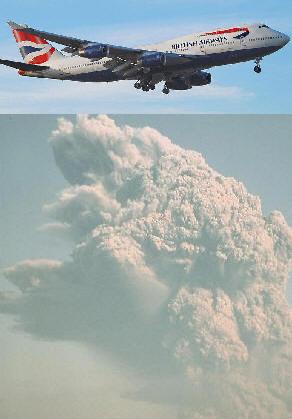 |
|
|
|
|
|
|||
|
By |
||||
 |
On 24 June 1982 -
British Airways Flight 9, sometimes referred to as the Speedbird 9 or
Jakarta incident, was a scheduled British Airways flight from London
Heathrow to Auckland, with stops in Bombay, Madras, Kuala Lumpur, Perth,
and Melbourne.
The aircraft was
diverted to
Shortly after
13:40 UTC (20:40 |
|||
|
|
||||
|
At approximately
13:42 UTC (20:42
Without engine
thrust, a 747-200 has a glide ratio of approximately 15:1 meaning it can
glide forward 15 kilometres for every kilometre it drops. The flight
crew quickly determined that the aircraft was capable of gliding for 23
minutes and covering 91 nautical miles (169 km) from its flight level of
11,000 metres (36,000 ft). At 13:44 UTC (20:44
However, Jakarta
Area Control misunderstood the message; interpreting the call as meaning
that only engine number four had shut down. It was only after a nearby
Garuda
Owing to the high
Indonesian mountains on the south coast of the
Despite the lack
of time, Moody made an announcement to the passengers that has been
described as "a masterpiece of understatement"
?Ladies and
gentlemen, this is your captain speaking. We have a small problem. All
four engines have stopped. We are doing our damnedest to get them under
control. I trust you are not in too much distress.?
As pressure within
the cabin fell, oxygen masks dropped from the ceiling - an automatic
emergency measure to make up for the lack of air. On the flight deck
however, Greaves's mask was broken; the delivery tube had detached from
the rest of the mask. Moody swiftly decided to descend at 1,800 m per
minute to an altitude where there was enough oxygen in the outside
atmosphere to breathe almost normally.
At 4,100 metres
(13,500 feet), they were approaching the altitude at which they would
have to turn over the ocean and attempt a risky ditching. Although there
were guidelines for the procedure, no one had ever tried it in a Boeing
747 ? nor have they since. As they performed the engine-restart
procedure, engine number four started, and at 13:56 UTC (20:56
As the aircraft
approached its target altitude, the St. Elmo's fire effect on the
windscreen returned. Moody throttled back, however engine number two
surged again and had to be shut down. The crew immediately descended and
held 3,600 metres (11,800 ft).
As Flight 9
approached |
| ?AvStop
Online Magazine
Contact
Us
Return To News
|
|
